TOYOTA AVENSIS 2014 Owners Manual (in English)
Manufacturer: TOYOTA, Model Year: 2014, Model line: AVENSIS, Model: TOYOTA AVENSIS 2014Pages: 776, PDF Size: 33.54 MB
Page 321 of 776
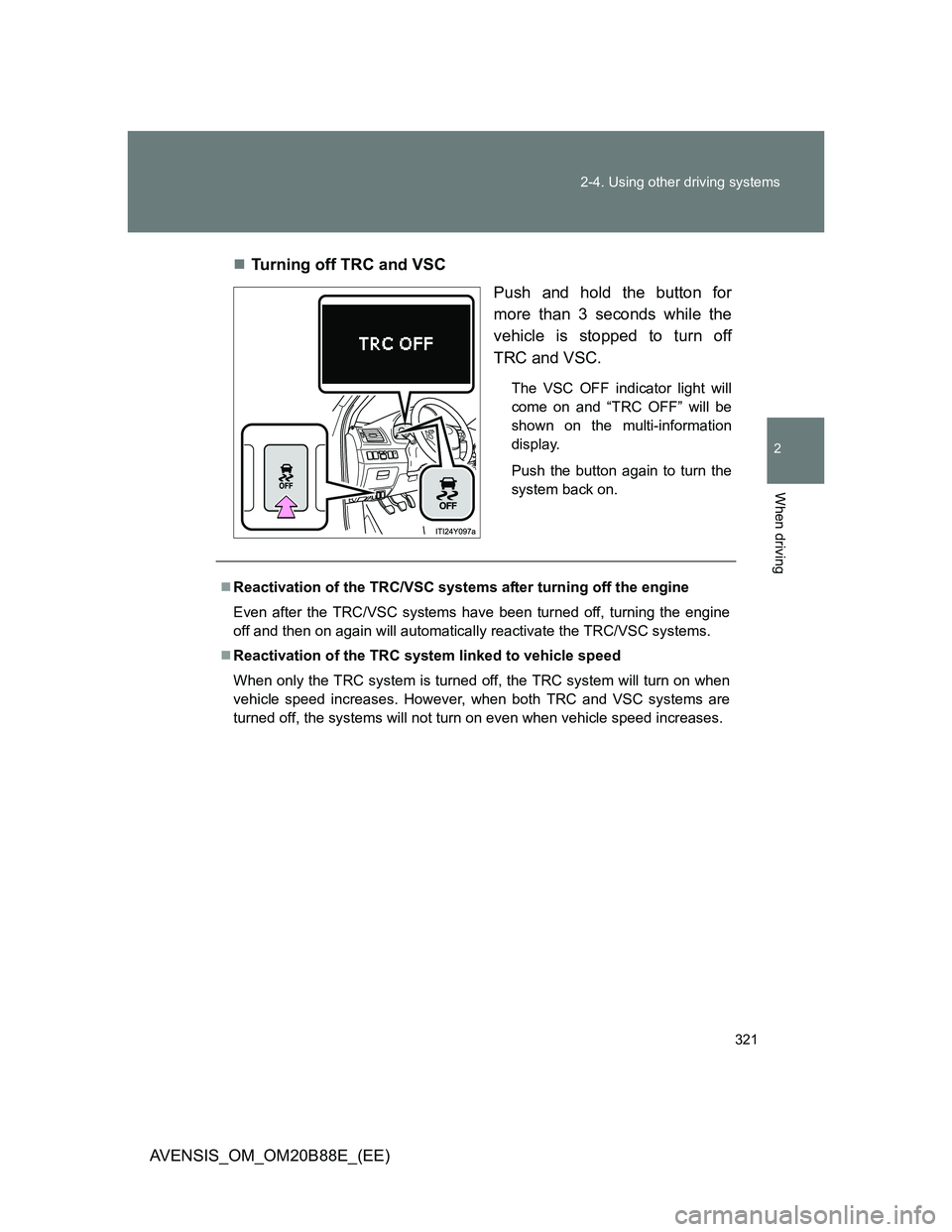
321 2-4. Using other driving systems
2
When driving
AVENSIS_OM_OM20B88E_(EE)Turning off TRC and VSC
Push and hold the button for
more than 3 seconds while the
vehicle is stopped to turn off
TRC and VSC.
The VSC OFF indicator light will
come on and “TRC OFF” will be
shown on the multi-information
display.
Push the button again to turn the
system back on.
Reactivation of the TRC/VSC systems after turning off the engine
Even after the TRC/VSC systems have been turned off, turning the engine
off and then on again will automatically reactivate the TRC/VSC systems.
Reactivation of the TRC system linked to vehicle speed
When only the TRC system is turned off, the TRC system will turn on when
vehicle speed increases. However, when both TRC and VSC systems are
turned off, the systems will not turn on even when vehicle speed increases.
Page 322 of 776
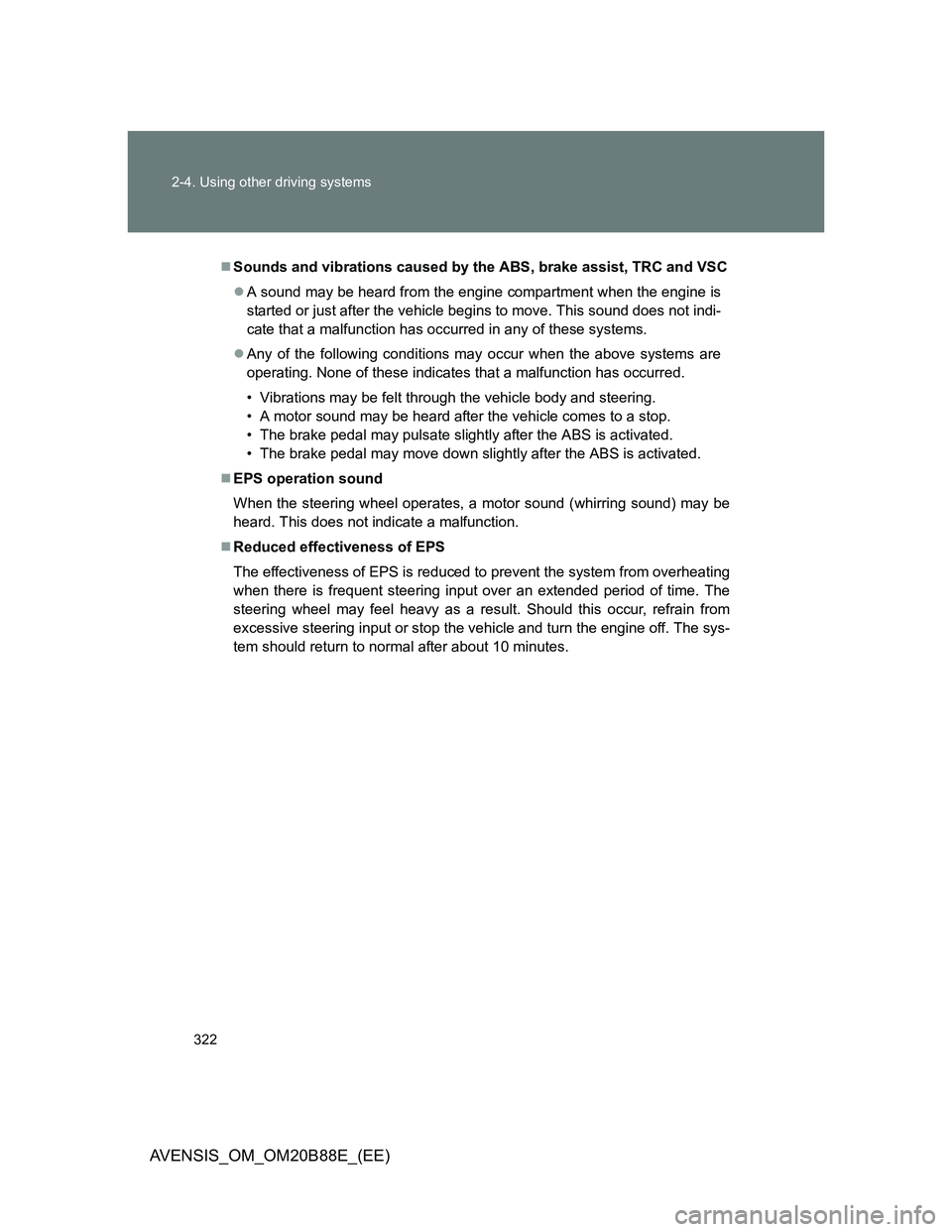
322 2-4. Using other driving systems
AVENSIS_OM_OM20B88E_(EE)
Sounds and vibrations caused by the ABS, brake assist, TRC and VSC
A sound may be heard from the engine compartment when the engine is
started or just after the vehicle begins to move. This sound does not indi-
cate that a malfunction has occurred in any of these systems.
Any of the following conditions may occur when the above systems are
operating. None of these indicates that a malfunction has occurred.
• Vibrations may be felt through the vehicle body and steering.
• A motor sound may be heard after the vehicle comes to a stop.
• The brake pedal may pulsate slightly after the ABS is activated.
• The brake pedal may move down slightly after the ABS is activated.
EPS operation sound
When the steering wheel operates, a motor sound (whirring sound) may be
heard. This does not indicate a malfunction.
Reduced effectiveness of EPS
The effectiveness of EPS is reduced to prevent the system from overheating
when there is frequent steering input over an extended period of time. The
steering wheel may feel heavy as a result. Should this occur, refrain from
excessive steering input or stop the vehicle and turn the engine off. The sys-
tem should return to normal after about 10 minutes.
Page 323 of 776
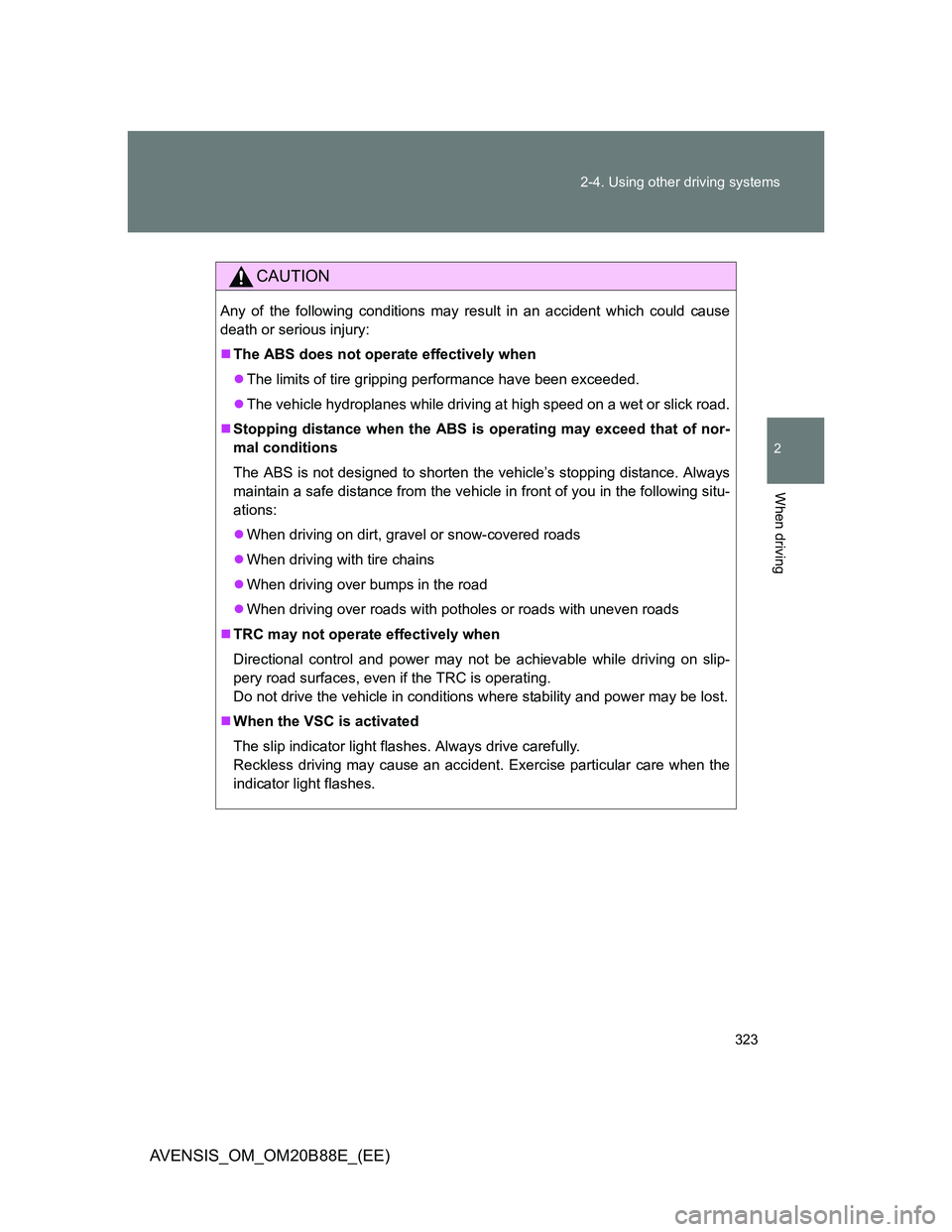
323 2-4. Using other driving systems
2
When driving
AVENSIS_OM_OM20B88E_(EE)
CAUTION
Any of the following conditions may result in an accident which could cause
death or serious injury:
The ABS does not operate effectively when
The limits of tire gripping performance have been exceeded.
The vehicle hydroplanes while driving at high speed on a wet or slick road.
Stopping distance when the ABS is operating may exceed that of nor-
mal conditions
The ABS is not designed to shorten the vehicle’s stopping distance. Always
maintain a safe distance from the vehicle in front of you in the following situ-
ations:
When driving on dirt, gravel or snow-covered roads
When driving with tire chains
When driving over bumps in the road
When driving over roads with potholes or roads with uneven roads
TRC may not operate effectively when
Directional control and power may not be achievable while driving on slip-
pery road surfaces, even if the TRC is operating.
Do not drive the vehicle in conditions where stability and power may be lost.
When the VSC is activated
The slip indicator light flashes. Always drive carefully.
Reckless driving may cause an accident. Exercise particular care when the
indicator light flashes.
Page 324 of 776
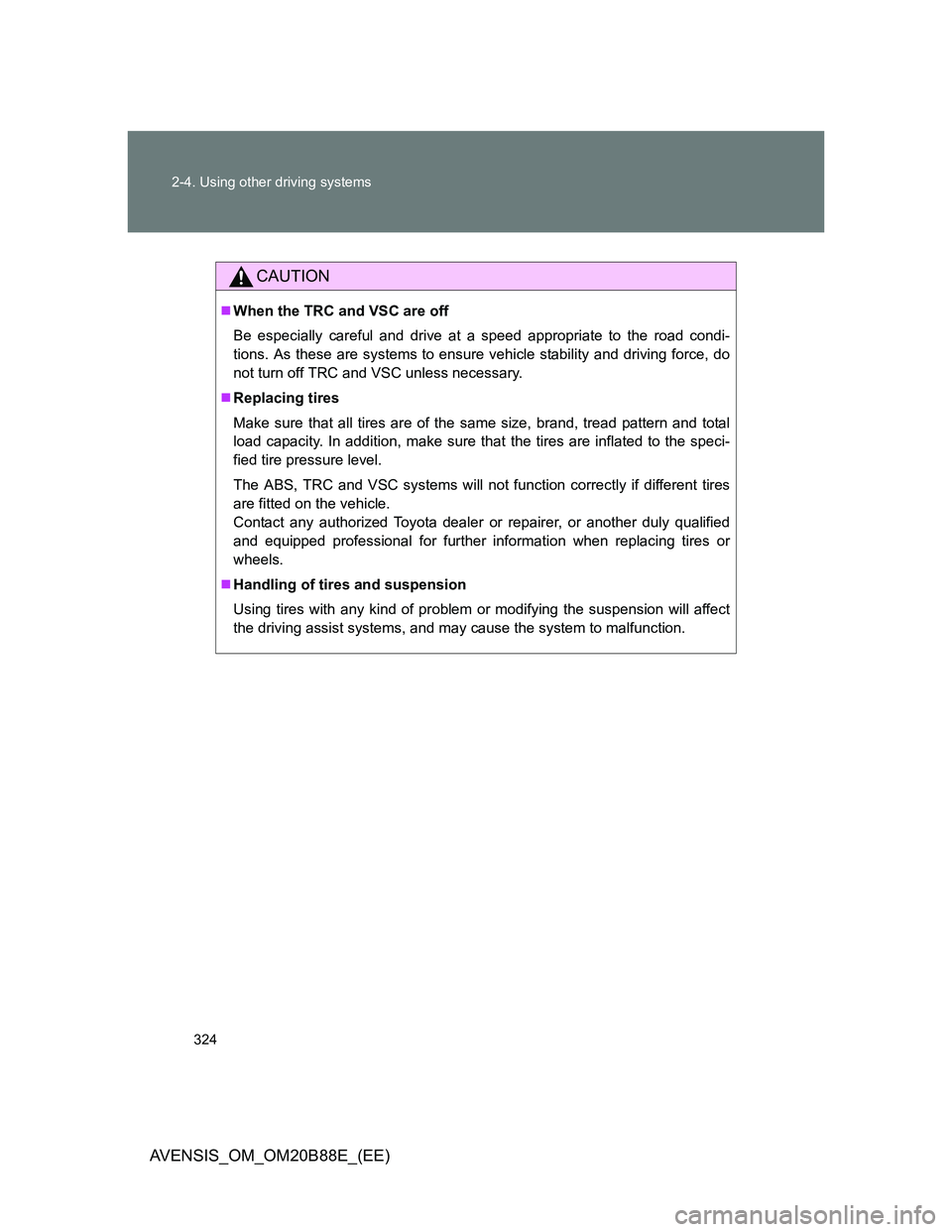
324 2-4. Using other driving systems
AVENSIS_OM_OM20B88E_(EE)
CAUTION
When the TRC and VSC are off
Be especially careful and drive at a speed appropriate to the road condi-
tions. As these are systems to ensure vehicle stability and driving force, do
not turn off TRC and VSC unless necessary.
Replacing tires
Make sure that all tires are of the same size, brand, tread pattern and total
load capacity. In addition, make sure that the tires are inflated to the speci-
fied tire pressure level.
The ABS, TRC and VSC systems will not function correctly if different tires
are fitted on the vehicle.
Contact any authorized Toyota dealer or repairer, or another duly qualified
and equipped professional for further information when replacing tires or
wheels.
Handling of tires and suspension
Using tires with any kind of problem or modifying the suspension will affect
the driving assist systems, and may cause the system to malfunction.
Page 325 of 776
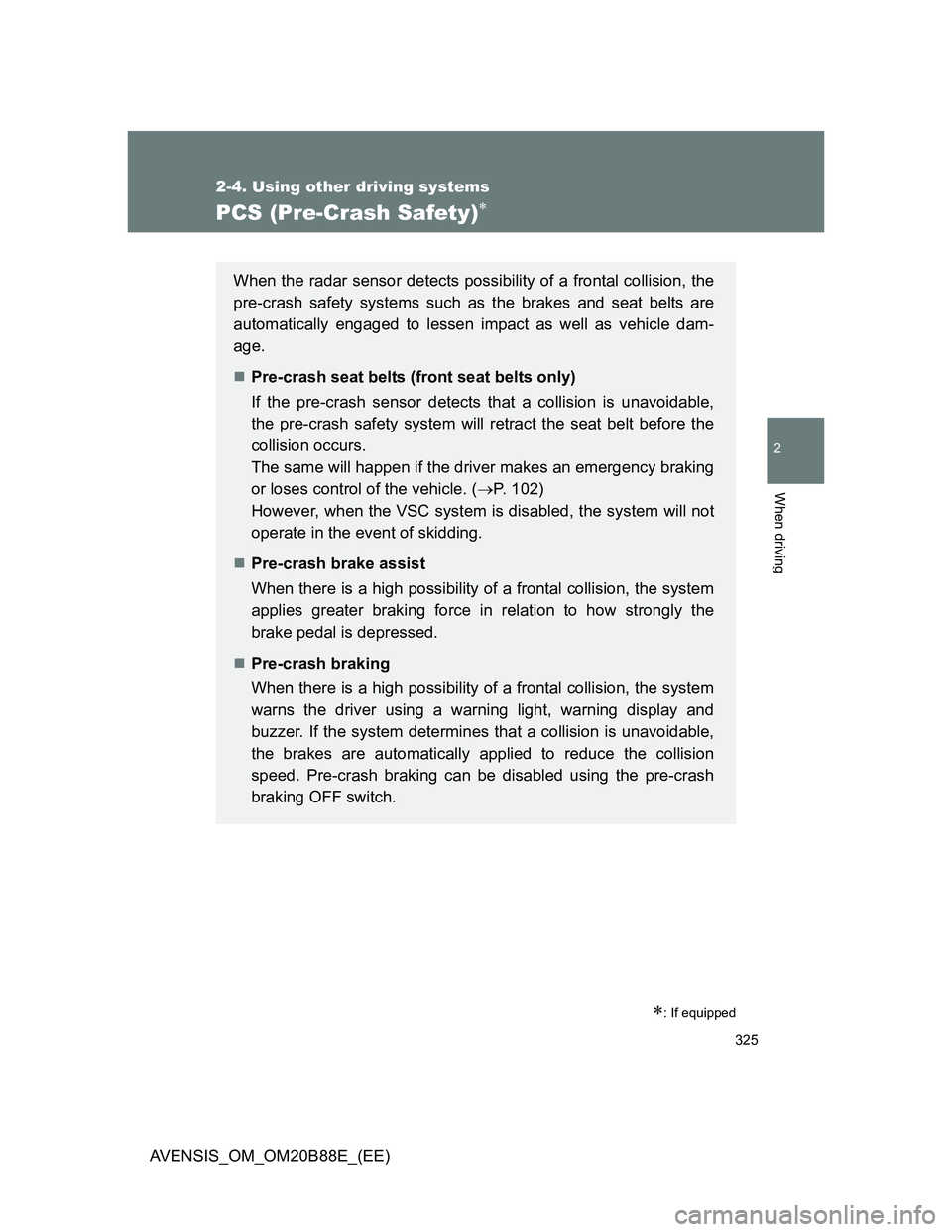
325
2-4. Using other driving systems
2
When driving
AVENSIS_OM_OM20B88E_(EE)
PCS (Pre-Crash Safety)
: If equipped
When the radar sensor detects possibility of a frontal collision, the
pre-crash safety systems such as the brakes and seat belts are
automatically engaged to lessen impact as well as vehicle dam-
age.
Pre-crash seat belts (front seat belts only)
If the pre-crash sensor detects that a collision is unavoidable,
the pre-crash safety system will retract the seat belt before the
collision occurs.
The same will happen if the driver makes an emergency braking
or loses control of the vehicle. (P. 102)
However, when the VSC system is disabled, the system will not
operate in the event of skidding.
Pre-crash brake assist
When there is a high possibility of a frontal collision, the system
applies greater braking force in relation to how strongly the
brake pedal is depressed.
Pre-crash braking
When there is a high possibility of a frontal collision, the system
warns the driver using a warning light, warning display and
buzzer. If the system determines that a collision is unavoidable,
the brakes are automatically applied to reduce the collision
speed. Pre-crash braking can be disabled using the pre-crash
braking OFF switch.
Page 326 of 776
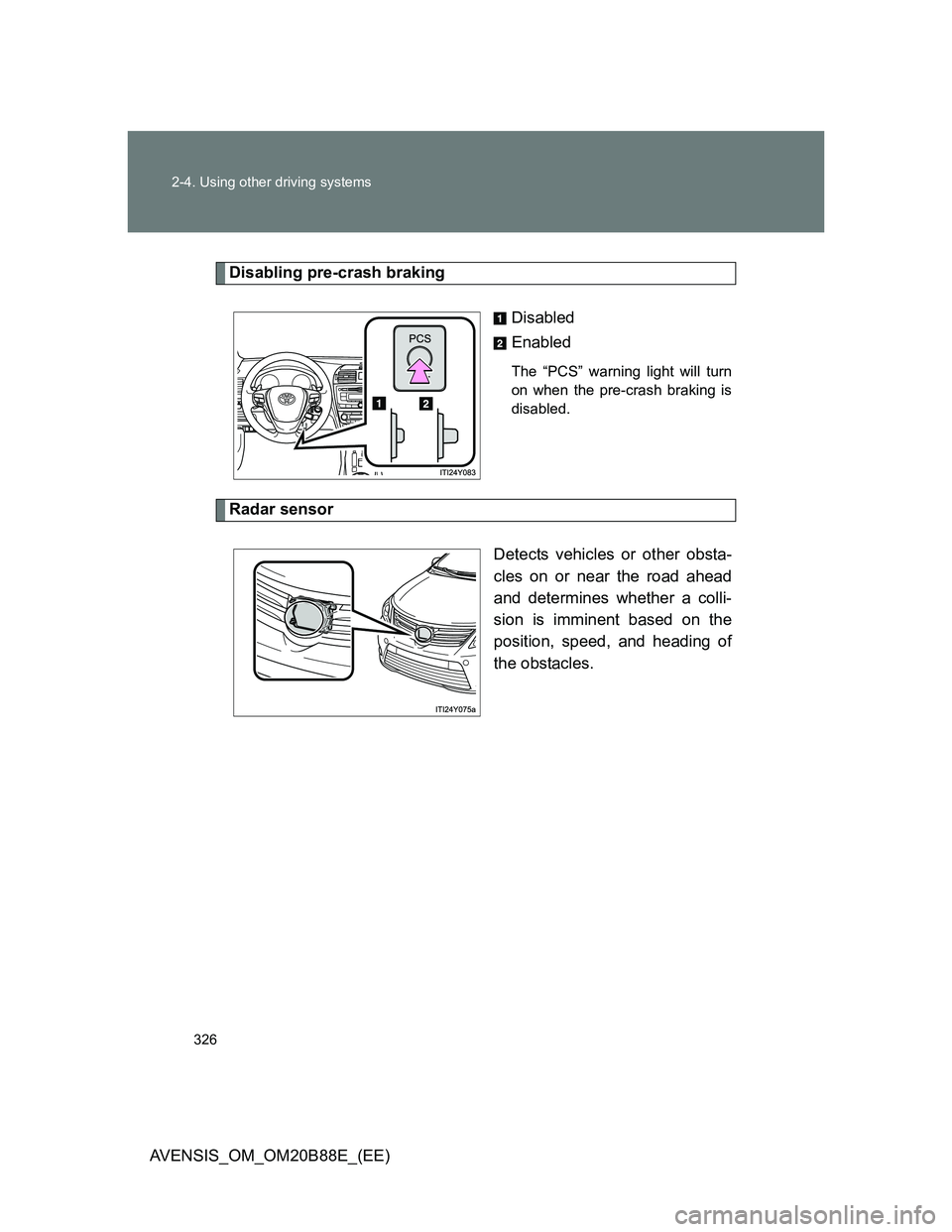
326 2-4. Using other driving systems
AVENSIS_OM_OM20B88E_(EE)
Disabling pre-crash braking
Disabled
Enabled
The “PCS” warning light will turn
on when the pre-crash braking is
disabled.
Radar sensor
Detects vehicles or other obsta-
cles on or near the road ahead
and determines whether a colli-
sion is imminent based on the
position, speed, and heading of
the obstacles.
Page 327 of 776
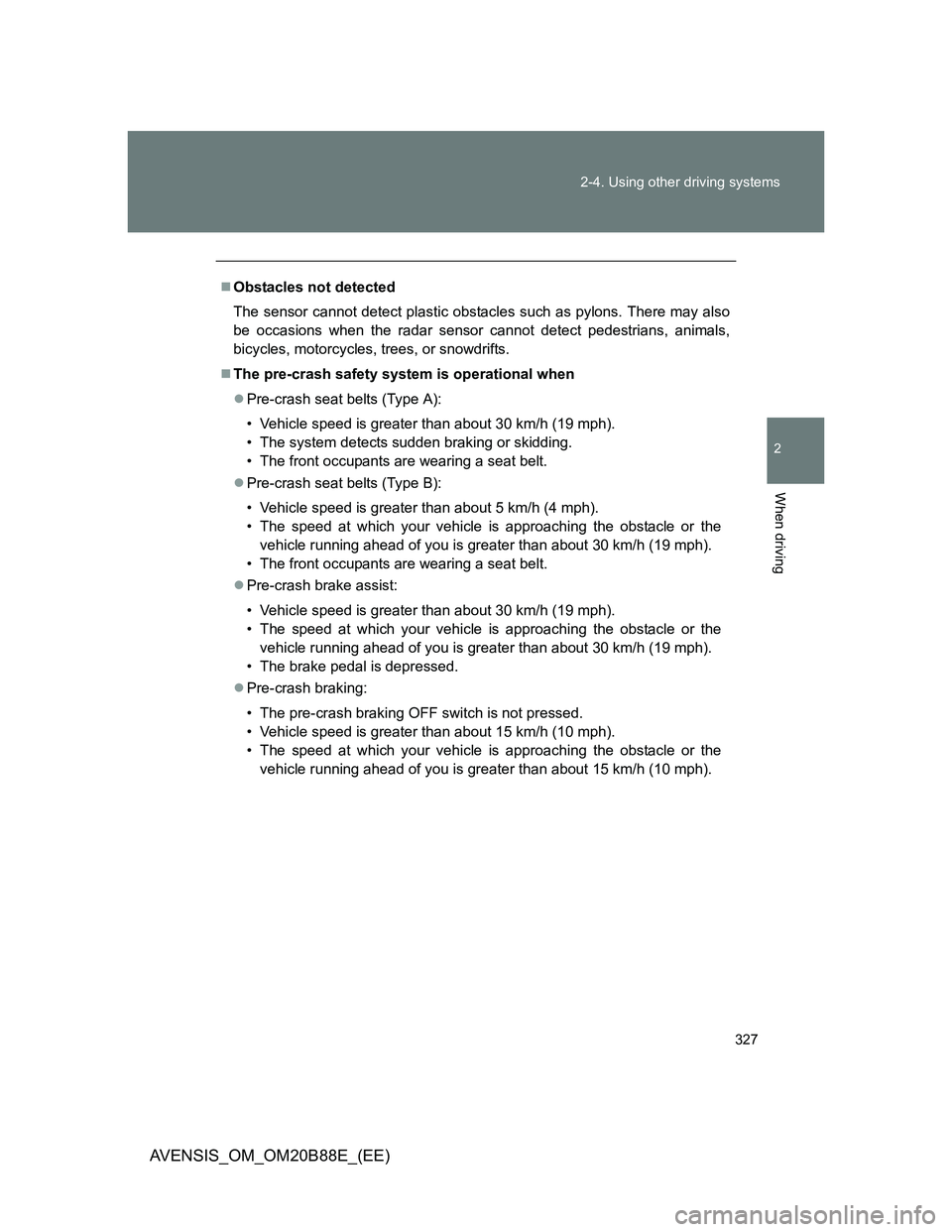
327 2-4. Using other driving systems
2
When driving
AVENSIS_OM_OM20B88E_(EE)
Obstacles not detected
The sensor cannot detect plastic obstacles such as pylons. There may also
be occasions when the radar sensor cannot detect pedestrians, animals,
bicycles, motorcycles, trees, or snowdrifts.
The pre-crash safety system is operational when
Pre-crash seat belts (Type A):
• Vehicle speed is greater than about 30 km/h (19 mph).
• The system detects sudden braking or skidding.
• The front occupants are wearing a seat belt.
Pre-crash seat belts (Type B):
• Vehicle speed is greater than about 5 km/h (4 mph).
• The speed at which your vehicle is approaching the obstacle or the
vehicle running ahead of you is greater than about 30 km/h (19 mph).
• The front occupants are wearing a seat belt.
Pre-crash brake assist:
• Vehicle speed is greater than about 30 km/h (19 mph).
• The speed at which your vehicle is approaching the obstacle or the
vehicle running ahead of you is greater than about 30 km/h (19 mph).
• The brake pedal is depressed.
Pre-crash braking:
• The pre-crash braking OFF switch is not pressed.
• Vehicle speed is greater than about 15 km/h (10 mph).
• The speed at which your vehicle is approaching the obstacle or the
vehicle running ahead of you is greater than about 15 km/h (10 mph).
Page 328 of 776
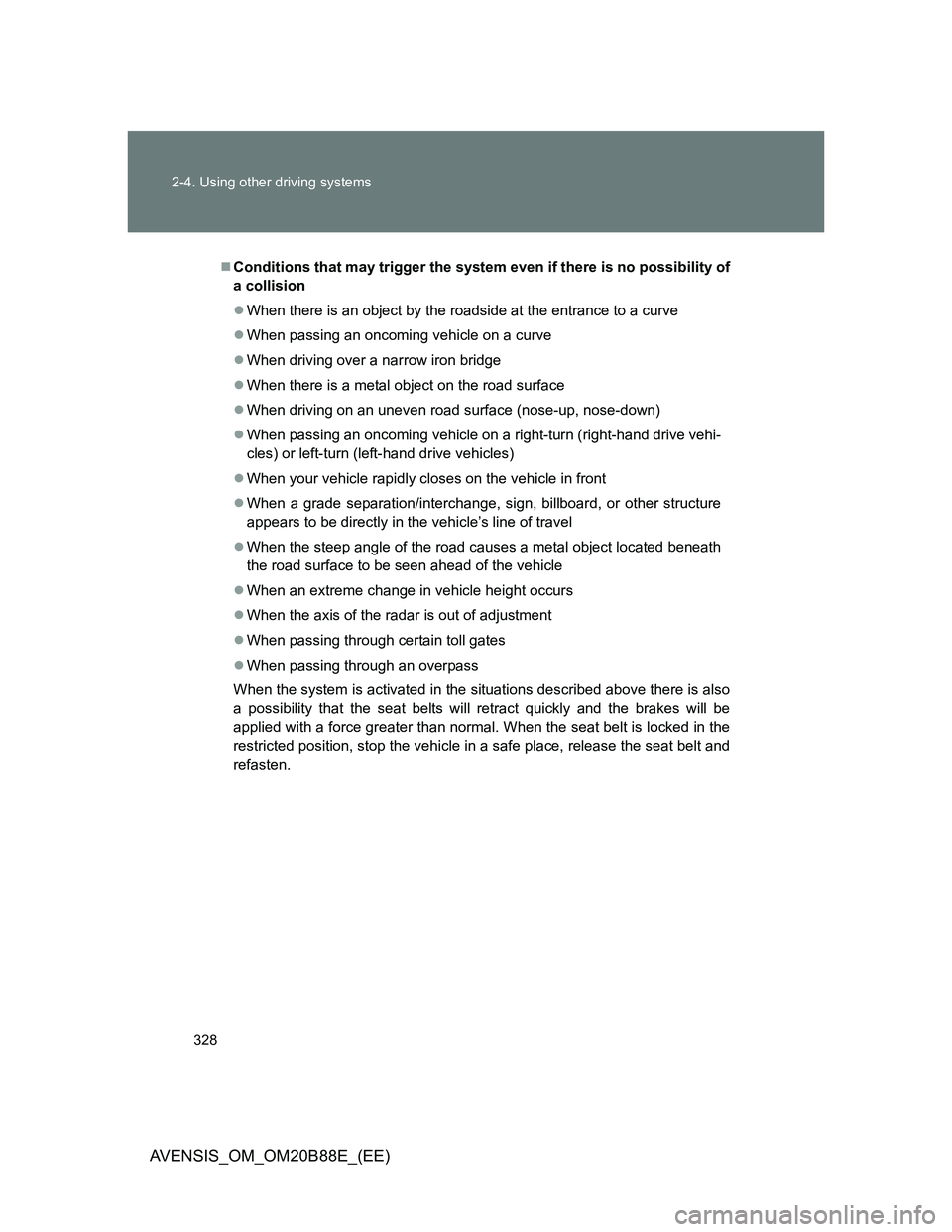
328 2-4. Using other driving systems
AVENSIS_OM_OM20B88E_(EE)
Conditions that may trigger the system even if there is no possibility of
a collision
When there is an object by the roadside at the entrance to a curve
When passing an oncoming vehicle on a curve
When driving over a narrow iron bridge
When there is a metal object on the road surface
When driving on an uneven road surface (nose-up, nose-down)
When passing an oncoming vehicle on a right-turn (right-hand drive vehi-
cles) or left-turn (left-hand drive vehicles)
When your vehicle rapidly closes on the vehicle in front
When a grade separation/interchange, sign, billboard, or other structure
appears to be directly in the vehicle’s line of travel
When the steep angle of the road causes a metal object located beneath
the road surface to be seen ahead of the vehicle
When an extreme change in vehicle height occurs
When the axis of the radar is out of adjustment
When passing through certain toll gates
When passing through an overpass
When the system is activated in the situations described above there is also
a possibility that the seat belts will retract quickly and the brakes will be
applied with a force greater than normal. When the seat belt is locked in the
restricted position, stop the vehicle in a safe place, release the seat belt and
refasten.
Page 329 of 776
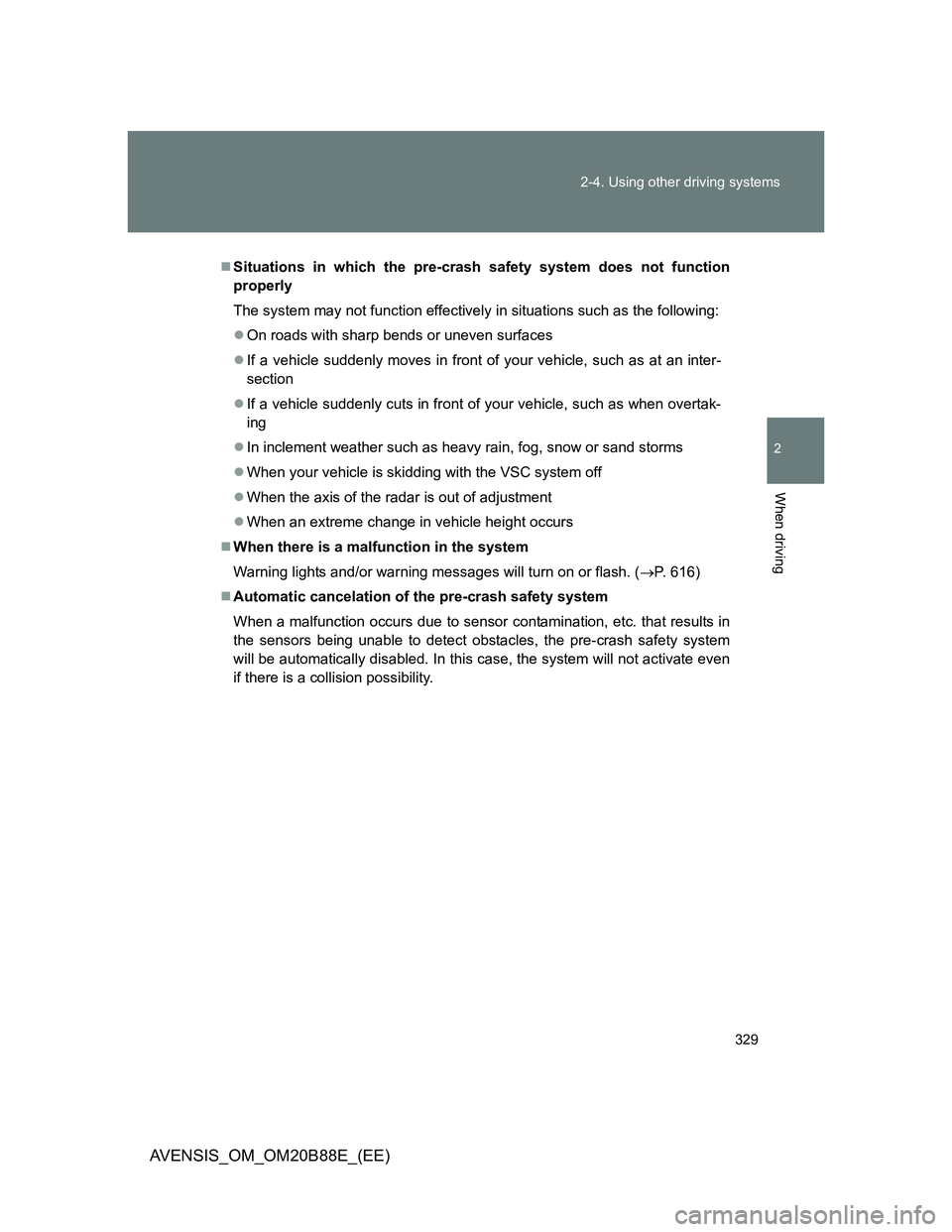
329 2-4. Using other driving systems
2
When driving
AVENSIS_OM_OM20B88E_(EE)
Situations in which the pre-crash safety system does not function
properly
The system may not function effectively in situations such as the following:
On roads with sharp bends or uneven surfaces
If a vehicle suddenly moves in front of your vehicle, such as at an inter-
section
If a vehicle suddenly cuts in front of your vehicle, such as when overtak-
ing
In inclement weather such as heavy rain, fog, snow or sand storms
When your vehicle is skidding with the VSC system off
When the axis of the radar is out of adjustment
When an extreme change in vehicle height occurs
When there is a malfunction in the system
Warning lights and/or warning messages will turn on or flash. (P. 616)
Automatic cancelation of the pre-crash safety system
When a malfunction occurs due to sensor contamination, etc. that results in
the sensors being unable to detect obstacles, the pre-crash safety system
will be automatically disabled. In this case, the system will not activate even
if there is a collision possibility.
Page 330 of 776
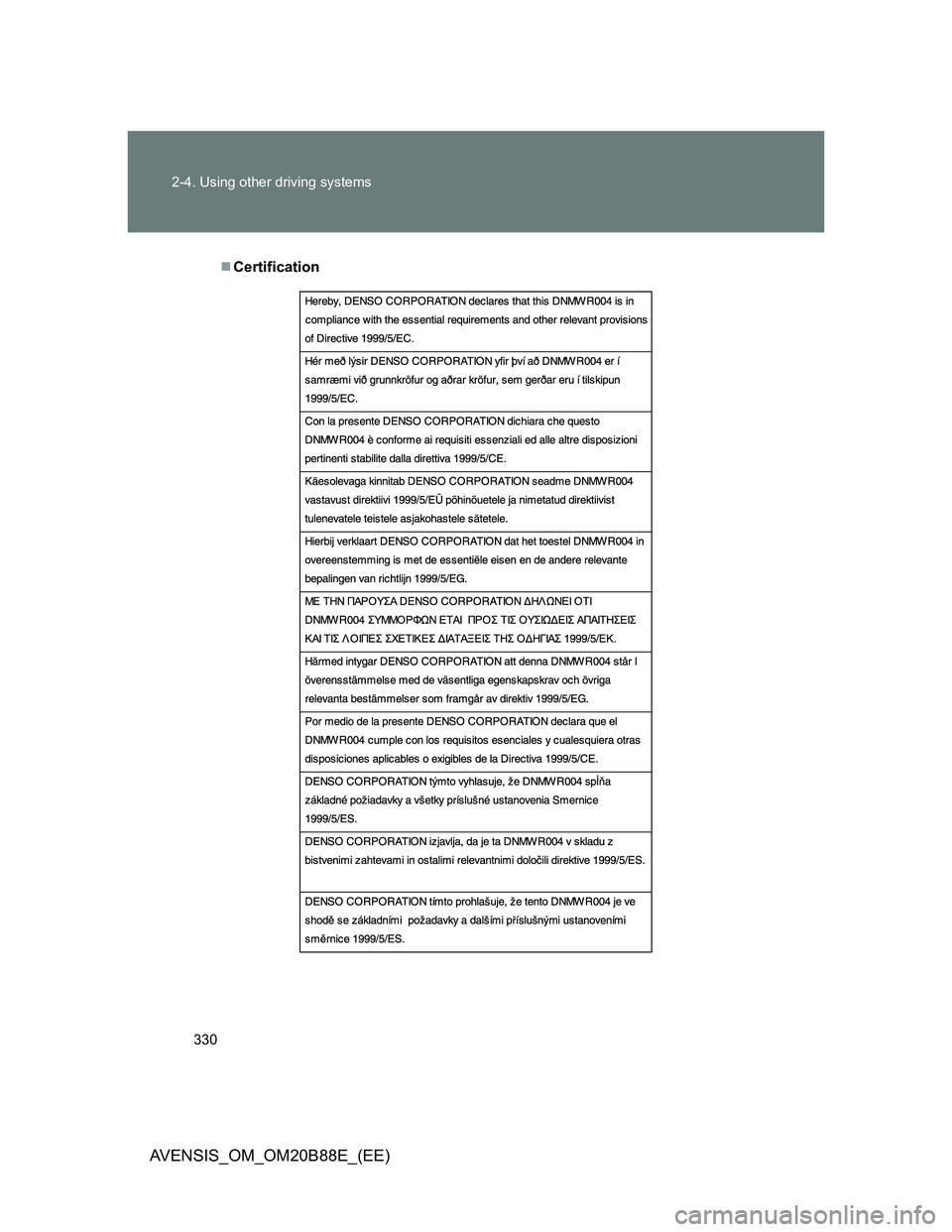
330 2-4. Using other driving systems
AVENSIS_OM_OM20B88E_(EE)
Certification